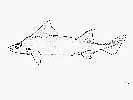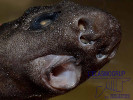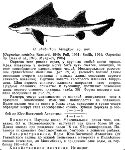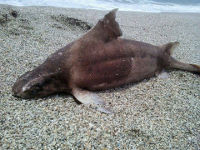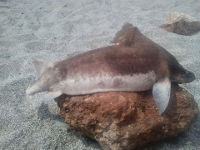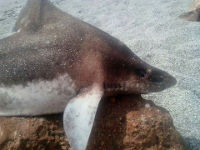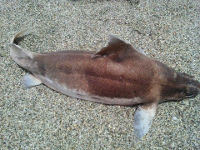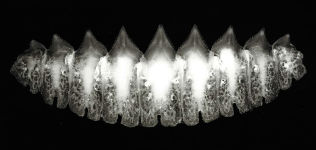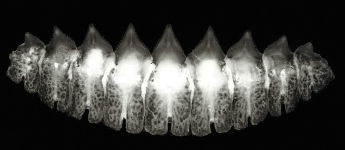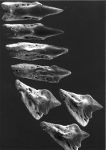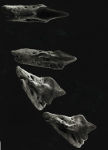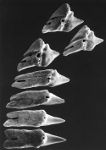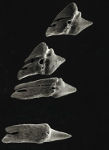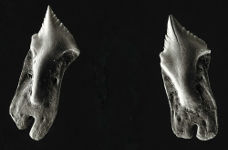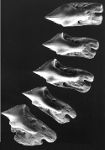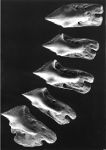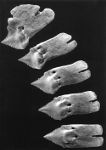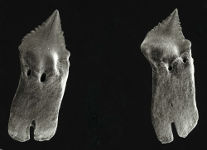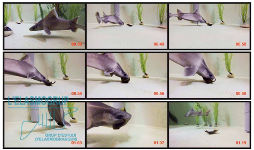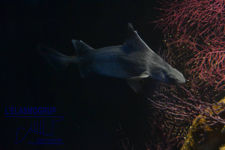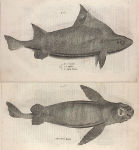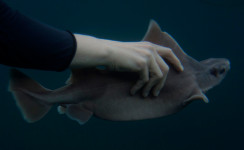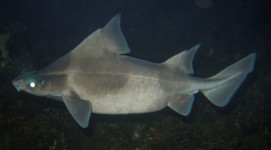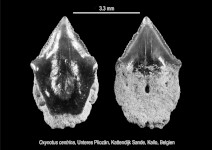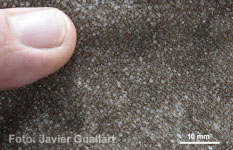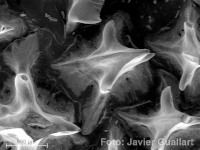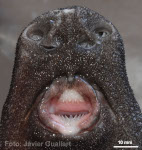Oxynotus centrina
(Linnaeus, 1758)
Angular roughshark
Classification: Elasmobranchii Squaliformes Oxynotidae
Reference of the original description
Systema Naturae per regna tria naturae, regnum animale, secundum classes, ordines, genera, species, cum characteribus differentiis synonymis, locis. Tomus I. Editio decima, reformata. Stockholm, Laurentii Salvii, 824pp.
Systema Naturae per regna tria naturae, regnum animale, secundum classes, ordines, genera, species, cum characteribus differentiis synonymis, locis. Tomus I. Editio decima, reformata. Stockholm, Laurentii Salvii, 824pp.
Image of the original description
No image in first description.
No image in first description.
Synonyms / new combinations and misspellings
Centrina centrina, Centrina salviani, Centrina salvianii, Centrina selviani, Centrina vulgaris, Centrina vulpecula, Oxynotus aff. centrina, Oxynotus cf. centrina, Oxynotus shubnikovi, Squalus centrina
Centrina centrina, Centrina salviani, Centrina salvianii, Centrina selviani, Centrina vulgaris, Centrina vulpecula, Oxynotus aff. centrina, Oxynotus cf. centrina, Oxynotus shubnikovi, Squalus centrina
Types
Oxynotus centrina
XXXX: No types known;
Centrina salviani
XXXX: No types known;
Centrina vulgaris
XXXX: No types known;
Oxynotus shubnikovi
Holotype: ZMMU: P-11505
Oxynotus centrina
XXXX: No types known;
Centrina salviani
XXXX: No types known;
Centrina vulgaris
XXXX: No types known;
Oxynotus shubnikovi
Holotype: ZMMU: P-11505
Description :
Citation: Oxynotus centrina (Linnaeus, 1758): In: Database of modern sharks, rays and chimaeras, www.shark-references.com, World Wide Web electronic publication, Version 05/2025
Please send your images of "Oxynotus centrina" to info@shark-references.com
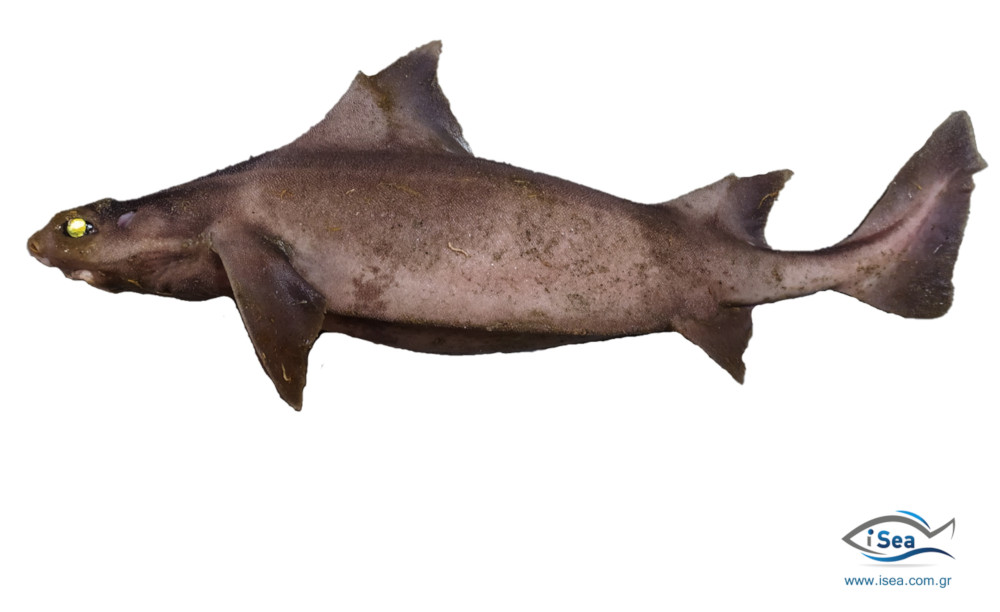
Oxynotus centrina (Linnaeus, 1758); adult, North Aegean Sea, close to Lemnos, Mediterranean Sea, TL= 56.2 cm © Roxanie Naasan Agah, Nikos Doumpas and Ioannis Giovos, www.isea.com.gr

Oxynotus centrina (Linnaeus, 1758); adult, North Aegean Sea, close to Lemnos, Mediterranean Sea, TL= 56.2 cm © Roxanie Naasan Agah, Nikos Doumpas and Ioannis Giovos, www.isea.com.gr
Common names
 Gefleckte Meersau,
Gefleckte Meersau,  Meersau,
Meersau,  Schweinshai,
Schweinshai,  Cerdo marino,
Cerdo marino,  Centrine commune,
Centrine commune,  Angular rough shark,
Angular rough shark,  Angular roughshark,
Angular roughshark,  Flatiron shark,
Flatiron shark,  Humantin,
Humantin,  Achilli,
Achilli,  Canischedda,
Canischedda,  Marzapanu,
Marzapanu,  Pesce porco,
Pesce porco,  Pesce puerche,
Pesce puerche,  Pesce puorco,
Pesce puorco,  Pescia porche,
Pescia porche,  Pesciu porcu,
Pesciu porcu,  Pisce puerche,
Pisce puerche,  Pisci ghianozzu,
Pisci ghianozzu,  Pisci porcu,
Pisci porcu,  Pisci surici,
Pisci surici,  Pisci trunzu,
Pisci trunzu,  Porchetta,
Porchetta,  Porco,
Porco,  Porcu,
Porcu,  Porcu di mari,
Porcu di mari,  Surci di funnali,
Surci di funnali,  Peixe-porco,
Peixe-porco,  Porco,
Porco,  Porco-marinho,
Porco-marinho,  Tambor,
Tambor,  Tubarão-leitão, Pixxiporku (malta)
Tubarão-leitão, Pixxiporku (malta)
 Gefleckte Meersau,
Gefleckte Meersau,  Meersau,
Meersau,  Schweinshai,
Schweinshai,  Cerdo marino,
Cerdo marino,  Centrine commune,
Centrine commune,  Angular rough shark,
Angular rough shark,  Angular roughshark,
Angular roughshark,  Flatiron shark,
Flatiron shark,  Humantin,
Humantin,  Achilli,
Achilli,  Canischedda,
Canischedda,  Marzapanu,
Marzapanu,  Pesce porco,
Pesce porco,  Pesce puerche,
Pesce puerche,  Pesce puorco,
Pesce puorco,  Pescia porche,
Pescia porche,  Pesciu porcu,
Pesciu porcu,  Pisce puerche,
Pisce puerche,  Pisci ghianozzu,
Pisci ghianozzu,  Pisci porcu,
Pisci porcu,  Pisci surici,
Pisci surici,  Pisci trunzu,
Pisci trunzu,  Porchetta,
Porchetta,  Porco,
Porco,  Porcu,
Porcu,  Porcu di mari,
Porcu di mari,  Surci di funnali,
Surci di funnali,  Peixe-porco,
Peixe-porco,  Porco,
Porco,  Porco-marinho,
Porco-marinho,  Tambor,
Tambor,  Tubarão-leitão, Pixxiporku (malta)
Tubarão-leitão, Pixxiporku (malta)
Short Description
Spiracle large and vertically elongated, crescent or oval in shape. Supraorbital ridges enlarged over eyes, with a knoblike posterior expansion studded with large denticles and ending in front of spiracles. Predorsal spine length from snout to first dorsal spine 2.6 to 2.8 in precaudal length. Pectoral fins leaf–shaped, not strongly falcate. Apices of dorsal fins broadly triangular, posterior margins shallowly concave. First dorsal–fin spine inclined forwards. First dorsal–fin anterior margin from spine to apex 0.8 to 1.0 in first dorsal–fin spine height, second dorsal–fin anterior margin from spine to apex 0.6 to 0.8 in second dorsal–fin spine height. Second dorsal–fin base 1.5 to 1.8 in interdorsal space, second dorsal–fin origin well anterior to pelvic–fin origins. Vertebral counts: total vertebral counts 91 to 94, monospondylous vertebral counts 46 to 50, total precaudal vertebral counts 61 to 66, caudal vertebral counts 26 to 30. Intestinal valve turn counts unavailable. [17836].
Diet:
yolk sacks and embryos from the small-spotted catshark Scyliorhinus canicula [8869];
exclusively on the contents of elasmobranch egg cases (Raja microocellata, Raja undulata, Scyliorhinus canicula, Scyliorhinus stellaris) [22916].
Spiracle large and vertically elongated, crescent or oval in shape. Supraorbital ridges enlarged over eyes, with a knoblike posterior expansion studded with large denticles and ending in front of spiracles. Predorsal spine length from snout to first dorsal spine 2.6 to 2.8 in precaudal length. Pectoral fins leaf–shaped, not strongly falcate. Apices of dorsal fins broadly triangular, posterior margins shallowly concave. First dorsal–fin spine inclined forwards. First dorsal–fin anterior margin from spine to apex 0.8 to 1.0 in first dorsal–fin spine height, second dorsal–fin anterior margin from spine to apex 0.6 to 0.8 in second dorsal–fin spine height. Second dorsal–fin base 1.5 to 1.8 in interdorsal space, second dorsal–fin origin well anterior to pelvic–fin origins. Vertebral counts: total vertebral counts 91 to 94, monospondylous vertebral counts 46 to 50, total precaudal vertebral counts 61 to 66, caudal vertebral counts 26 to 30. Intestinal valve turn counts unavailable. [17836].
Diet:
yolk sacks and embryos from the small-spotted catshark Scyliorhinus canicula [8869];
exclusively on the contents of elasmobranch egg cases (Raja microocellata, Raja undulata, Scyliorhinus canicula, Scyliorhinus stellaris) [22916].
Distribution
Eastern Atlantic from Norway to Portugal and extending southward to Madeira Islands, the Canary Islands, Morocco, Mauritania, to the Gulf of Guinea region, south to Gabon, Angola, Namibia, and South Africa (Western Cape). Also, throughout the Mediterranean Sea along the entire coast from the Straits of Gibraltar to Israel, but absent from the Black Sea. Possibly off Mozambique in the Western Indian Ocean, but whether it is this or a different species requires confirmation. [17836]
Records:
10.11.2000 and 02.01.2001 by the fishing vessel "Maireta II" at a depth of 192 m at Catalonia's continental slope waters (Spain, 41 °12' N, 2°28' E, males, both 55,5 cm, coll.nr.: Zoology Museum of Barcelona, MZB-2000-1035 and MZB-2001-0006) [8869]
07.07.2007 by long line in Croatian waters at the eastern coast of the Adriatic Sea at a depth of 60 m (adult female, 7883 g, 800 mm TL) [6164];
list of records in Turkish waters (12 records, 1942-2009, TL 22,5 cm - 65 cm) [16804];
2006-2011, Greek Seas, Mediterranean Sea (Psara, Korinthiakos Gulf, Evia) TL 53,3 cm - 79,0 cm; Weight: 1649 gr - 5020gr [16802];
27.09.2009, between 16:00 to 16:05, from the northern coast of the Sea of Marmara, north-western Turkey, at a depth of 30 m (female, ca. 60 cm TL) [12608] video: Source: www.gbif.org
Eastern Atlantic from Norway to Portugal and extending southward to Madeira Islands, the Canary Islands, Morocco, Mauritania, to the Gulf of Guinea region, south to Gabon, Angola, Namibia, and South Africa (Western Cape). Also, throughout the Mediterranean Sea along the entire coast from the Straits of Gibraltar to Israel, but absent from the Black Sea. Possibly off Mozambique in the Western Indian Ocean, but whether it is this or a different species requires confirmation. [17836]
Records:
10.11.2000 and 02.01.2001 by the fishing vessel "Maireta II" at a depth of 192 m at Catalonia's continental slope waters (Spain, 41 °12' N, 2°28' E, males, both 55,5 cm, coll.nr.: Zoology Museum of Barcelona, MZB-2000-1035 and MZB-2001-0006) [8869]
07.07.2007 by long line in Croatian waters at the eastern coast of the Adriatic Sea at a depth of 60 m (adult female, 7883 g, 800 mm TL) [6164];
list of records in Turkish waters (12 records, 1942-2009, TL 22,5 cm - 65 cm) [16804];
2006-2011, Greek Seas, Mediterranean Sea (Psara, Korinthiakos Gulf, Evia) TL 53,3 cm - 79,0 cm; Weight: 1649 gr - 5020gr [16802];
27.09.2009, between 16:00 to 16:05, from the northern coast of the Sea of Marmara, north-western Turkey, at a depth of 30 m (female, ca. 60 cm TL) [12608] video: Source: www.gbif.org
Human uses
fisheries: minor commercial; price category: high; price reliability: reliable: based on ex-vessel price for this species
fisheries: minor commercial; price category: high; price reliability: reliable: based on ex-vessel price for this species
Biology
Viviparous with a yolk–sac, litters of 7 to 23; ovarian eggs may be up to 40 to 60 mm in diameter [17836].
Diet: dataset: 102 specimens (55 males, 47 females, 57 were empty): The diet of O. centrina consisted of one major systematic group, Polychaeta (% IRI = 60.01), three accessory groups, Sipunculidae (% IRI = 18.56), Crustacea (% IRI = 13.95) and Teleostei (% IRI = 7.43), one occasional group, Echinodermata (% IRI = 18.44) and a particular polychaete, Platynereis dumerilii (% IRI = 13.33). O. centrina is a suction feeder specialized in wormlike preys. [22761];
one immature male, four elasmobranch species, R. microocellata, undulate ray Raja undulata Lacépède 1802, S. canicula and large-spotted catshark Scyliorhinus stellaris [22916]
Viviparous with a yolk–sac, litters of 7 to 23; ovarian eggs may be up to 40 to 60 mm in diameter [17836].
Diet: dataset: 102 specimens (55 males, 47 females, 57 were empty): The diet of O. centrina consisted of one major systematic group, Polychaeta (% IRI = 60.01), three accessory groups, Sipunculidae (% IRI = 18.56), Crustacea (% IRI = 13.95) and Teleostei (% IRI = 7.43), one occasional group, Echinodermata (% IRI = 18.44) and a particular polychaete, Platynereis dumerilii (% IRI = 13.33). O. centrina is a suction feeder specialized in wormlike preys. [22761];
one immature male, four elasmobranch species, R. microocellata, undulate ray Raja undulata Lacépède 1802, S. canicula and large-spotted catshark Scyliorhinus stellaris [22916]
Size / Weight / Age
150 cm TL, size at birth is 21 to 24 cm, females maturing at about 65 cm (northern part of range) and abour 52-58 cm (southern part of range), males maturing at about 60 cm (male/unsexed; [17836])
150 cm TL, size at birth is 21 to 24 cm, females maturing at about 65 cm (northern part of range) and abour 52-58 cm (southern part of range), males maturing at about 60 cm (male/unsexed; [17836])
Dentition
Teeth on upper and lower jaws dissimilar; uppers smaller than lowers, lanceolate, narrowly erect, awl–shaped in the central rows, broadly triangular and blade–like in the posterior rows, smooth–edged cusps and no lateral cusplets or blades, in quincunx formation in a narrow triangular pad and not imbricated; lower teeth imbricated, with a medially erect, distally oblique broad, sharp– edged, serrated cusp, with no lateral cusplets; tooth row counts upper jaw 9 to 11, lower jaw 9 [17836], tooth formula (9-11)/4-1-4 (n=5) [3640]
Links: SEM-images of teeth
Teeth on upper and lower jaws dissimilar; uppers smaller than lowers, lanceolate, narrowly erect, awl–shaped in the central rows, broadly triangular and blade–like in the posterior rows, smooth–edged cusps and no lateral cusplets or blades, in quincunx formation in a narrow triangular pad and not imbricated; lower teeth imbricated, with a medially erect, distally oblique broad, sharp– edged, serrated cusp, with no lateral cusplets; tooth row counts upper jaw 9 to 11, lower jaw 9 [17836], tooth formula (9-11)/4-1-4 (n=5) [3640]
Links: SEM-images of teeth
Remarks
shark-references Species-ID=4478;
shark-references Species-ID=4478;










